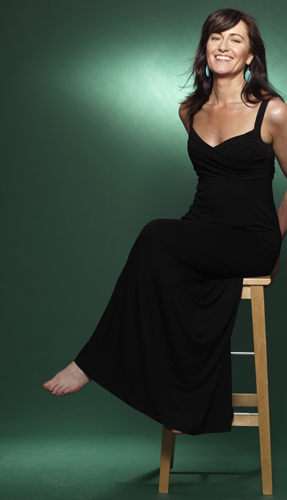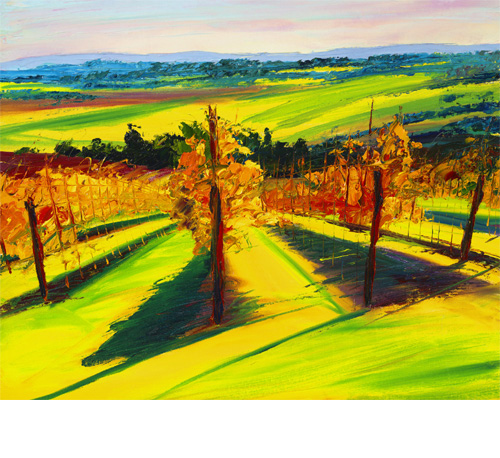By Carolyn Edlund
Artist advisor Ann Rea shares her wisdom and ideas for artists who want to build a successful business.

Ann Rea paints vibrant and light-filled canvases depicting the California Wine Country. Her artwork and her success are far from ordinary, and she has planned it that way. With a background in both art and business, Ann used smart strategies and marketing skill to launch a very profitable career. She continues to develop her business and has decided to write a book on marketing fine art. Ann coaches and consults with selected artists from across the globe, some of whom will be profiled in her book.. Ann spoke with us recently about how she achieved her success, and offers her insights.
AS: What is a “blue ocean strategy” and how did you use this as an artist?
AR: Blue Ocean Strategy is a business book written by W. Chan Kim and Renée Mauborgne. It promotes creating new market space or “Blue Ocean” rather than competing in an existing industry. By creating unique value one eliminates the competition and swims in a blue ocean versus competing and swimming with the sharks in a red ocean of blood. I didn’t even know that what I had created had a name until about three years after I started my business.
What I did know was that marketing and sales 101 tells us that it’s not about you, it’s all about your customer. So I created a business model that helps wineries leverage their largest asset, the unique beauty of their vineyards. I maintain creative control so I decide how and what to paint. I’m not an illustrator.
AS: How do you create value in an overcrowded, saturated art market?
AR: You have to be crystal clear about the market you’re targeting and the unique value you are offering that market. It’s different for everyone, as it should be. This is what I help artists identify and target. I help them identify their market and communicate their unique value. Andy Warhol, Michelangelo, and Sargent businesses are excellent examples of offering clear value to a defined market.
Most artists think it’s about finding an audience that will appreciate them. That’s nice but that’s just not how business works.
AS: Why do you not license your work?
AR: I don’t license my work because I’m building my own brand, Ann Rea, Inc., and catalog of fine art merchandise. There’s some short-term gain in licensing but long term it would be a bad move. In fact, my first wine label sold a ton of wine, and this was a new brand we made up at the winemaker’s kitchen table. But I wasn’t paid much and the winemaker was extremely unprofessional. So I decided that the next wine label that I design with be for my wine, not someone else’s wine.
Imagine if Led Zeppelin licensed their music to Cadillac early in their career. Their brand and image is so solid now that they can do this and it doesn’t dilute their brand. Although some might argue this point.
AS: How did you appeal to collectors and take your business to the next level?
AR: These are two different questions. I appeal to my collectors by connecting with them and nurturing genuine relationships. I also really like my collectors. They are lovely people. My goal is to be accessible and friendly. And to make their experience enjoyable and memorable.
The more collectors I appeal to, the more my base will grow and my sales will increase.
AS: What are the biggest mistakes you see artists make in planning their careers?
AR: That’s easy to answer. The biggest mistake that I see an artist making early, and sometimes too late, in their career is that they do not recognize, and or respect the fact they are indeed “in business.”
They need to be savvy entrepreneurs. But they are trying, often without much success, to follow a prescribed model of working solely with galleries and keeping their fingers crossed that one day that this tired formula will work. The problem is that 99.9% of the time, it doesn’t. And if it does, too many art galleries fold.
Part of this mindset is ingrained by a cultural stereotype that artists should not, or could not, be concerned with money and or business. I can’t tell you how much I hear this disrespectful assumption.
The good news is that there is a lot of money changing hands in the art industry, and artists can get their piece of the pie.
I’ll remind artists that I consult with that no one is going to “discover” them, no one is coming to save them. But once an artist recognizes, respects, and embraces their business, we’re ready to work together.
AS: What do you have planned next in your business?
AR: I’m targeting certain high net worth collectors for custom commissioned paintings. This is a narrow luxury market segment that requires a high degree of service and who wants a unique experience. I’m currently completing intense sales training that will help me better target this market.



Thank you Ann for sharing your real life experience in creating your art for your target market. I also agree that artists can make wise decisions in business and with money; we have the problem solving skills! Thanks for the encouragement.
Nice post. The aim of Blue Ocean Strategy is not to out-perform the competition in the existing industry, but to create new market space or a blue ocean, thereby making the competition irrelevant. I think it is better to create new market space or a blue ocean rather than competing in the existing market.
Yes, blue ocean strategy is a fascinating concept and you can see how it’s been used a lot today. Twitter for instance – a market never existed before they created it. Just got an email this morning that Twitter grew 1500% last year. Nice!
Excellent. Thank you Ann.